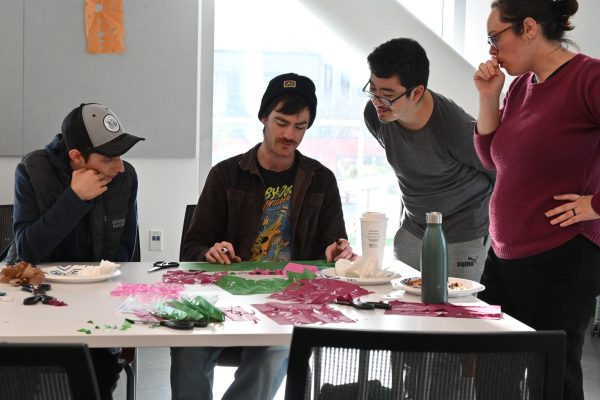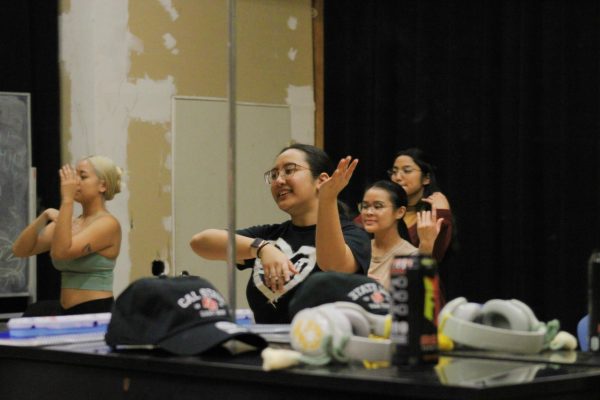Artist uses doll to express alter ego
A black fashion doll, clothed in a black dress and a neon pink “pussy” hat, rose stark against a sea of protesters at the Oakland Women’s March on Jan. 20, as her creator Stephan Davidich held her high above the chaos to snap a photo.
Her name is Deja Dohl and Davidich crafted her out of a wax mold and resin. Her hair is styled in cornrows made of Velcro and all her clothes are handmade by him. The hat was made out of a white Sunday-school style sock from a dollar store, accentuated with hot glue and a pink highlighter pen the morning of the march.
“I didn’t have time to break out the sewing machine,” he said.
Davidich has been sculpting wax since 1980. He discovered his interest in art as a kid when he made his first figurine at Clear Lake Camp in Michigan. His mother, who majored in art in college and ran the ceramics department at the camp, got him in for free.
He graduated from Eastern Michigan University with a major in fine arts and a minor in industrial technology, which allowed him to make electronic sculptures, and work with metal and plastics. In 1988, the year before he moved to the Bay Area, he found a niche in the doll community.
Davidich has spent 11 years working to perfect Deja’s image. Deja is a character as much as she is a sculpture, who represents different women he’s known throughout his life. “Her character is a girl in college who is very politically aware,” he said. “She is also an alter ego for me and expresses my views.”
Deja’s creation is tied to a group called the Black and Beautiful Doll Club, a club dedicated to black fashion dolls that was established by Brenda Blanchard in Los Angeles in the late 1990s. In 2006 the club hosted the National Barbie Convention which featured the first black official convention Doll, according to the Black and Beautiful Doll Club’s Facebook page. Prior to that, the event was promoted by Mattel. After Blanchard passed away suddenly in 2011, Davidich and another member kept the club alive through Facebook.
According to the group’s Facebook page, there was no black option for the official convention dolls before 2004, so collectors of color were forced to buy an extra doll so they could re-dress their black doll in the white convention doll’s outfit “to simulate a convention doll that represented them.”
The first black fashion doll made by Mattel was Christie in 1968 in an effort to align with the Civil Rights Movement. It wasn’t until 1980 that Mattel made an African American version of Barbie, according to Davidich.
Last January, Mattel released three new body types for Barbie; tall, curvy and petite, as well as seven skin tones, 24 hairstyles and 22 eye colors, according to Mattel.
The idea for Deja materialized in 1999 from club discussions about the lack of black dolls on the market. It wasn’t until 2006, through the urging of the club, that Davidich decided to create his own black doll.
Deja was born out of rich tradition of handmade black dolls that dates back to the days of slavery, according to Davidich. Within the club, she has become an emblem for a political movement to help the black community improve its self-image.
“When you see me protesting, holding my doll, it’s the tip of the iceberg with these people in the Barbie community,” said Davidich.
Although she resembles a Barbie doll, Davidich said she is anything but. A standard Barbie is just under 12 inches, but Deja measures 16. She was largely inspired by Shani, a black fashion doll with a more “ethnic shape” than Barbie that was released in 1991, according to Davidich.
Davidich used a wax mold to cast the doll in resin. However his first attempt didn’t go as planned: the resin leaked and the silicone formed bubbles, creating what looked like craters and warts on her surface. Davidich had no choice but to start over, creating the version of Deja that he carries today.
“When you’re in that zone it’s just so amazing, and there are times when it’s so frustrating,” he said. “I’m still recovering from that. Even though I’ve come past the technical issues, the feelings of redoing something ten times over is really, really difficult.”
Davidich said the wax can cost anywhere from $50 to $80 and silicone molds around $300. He made his own pressure chamber, used to compress the silicone bubbles, out of an air conditioner compressor.
He wanted Deja to look as life-like as possible, so he fashioned her with movable joints. The inspiration for her facial features came from photos. “I work mostly off of photographs,” he said. “If I have a good front and side view of a face, I can pretty much reconstruct it.”
Davidich plans to create two other ethnic dolls with different skin tones, body types and features as part of a series, along with Deja. He also aims to create dolls to sell as “mannequins,” to other artists to customize.
“When you’re doing art, you get into the zone and the whole world disappears and it’s just you and your piece, you get extremely focused,” said Davidich. “It’s the closest thing to nirvana that you can get to.”













